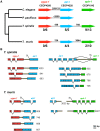Operons are a conserved feature of nematode genomes
- PMID: 24931407
- PMCID: PMC4125394
- DOI: 10.1534/genetics.114.162875
Operons are a conserved feature of nematode genomes
Abstract
The organization of genes into operons, clusters of genes that are co-transcribed to produce polycistronic pre-mRNAs, is a trait found in a wide range of eukaryotic groups, including multiple animal phyla. Operons are present in the class Chromadorea, one of the two main nematode classes, but their distribution in the other class, the Enoplea, is not known. We have surveyed the genomes of Trichinella spiralis, Trichuris muris, and Romanomermis culicivorax and identified the first putative operons in members of the Enoplea. Consistent with the mechanism of polycistronic RNA resolution in other nematodes, the mRNAs produced by genes downstream of the first gene in the T. spiralis and T. muris operons are trans-spliced to spliced leader RNAs, and we are able to detect polycistronic RNAs derived from these operons. Importantly, a putative intercistronic region from one of these potential enoplean operons confers polycistronic processing activity when expressed as part of a chimeric operon in Caenorhabditis elegans. We find that T. spiralis genes located in operons have an increased likelihood of having operonic C. elegans homologs. However, operon structure in terms of synteny and gene content is not tightly conserved between the two taxa, consistent with models of operon evolution. We have nevertheless identified putative operons conserved between Enoplea and Chromadorea. Our data suggest that operons and "spliced leader" (SL) trans-splicing predate the radiation of the nematode phylum, an inference which is supported by the phylogenetic profile of proteins known to be involved in nematode SL trans-splicing.
Keywords: SL trans-splicing; nematode genome; operons.
Copyright © 2014 by the Genetics Society of America.
Figures





Similar articles
-
Resolution of polycistronic RNA by SL2 trans-splicing is a widely conserved nematode trait.RNA. 2020 Dec;26(12):1891-1904. doi: 10.1261/rna.076414.120. Epub 2020 Sep 4. RNA. 2020. PMID: 32887788 Free PMC article.
-
Spliced leader trans-splicing in the nematode Trichinella spiralis uses highly polymorphic, noncanonical spliced leaders.RNA. 2008 Apr;14(4):760-70. doi: 10.1261/rna.948008. Epub 2008 Feb 6. RNA. 2008. PMID: 18256244 Free PMC article.
-
SL2-like spliced leader RNAs in the basal nematode Prionchulus punctatus: New insight into the evolution of nematode SL2 RNAs.RNA. 2010 Aug;16(8):1500-7. doi: 10.1261/rna.2155010. Epub 2010 Jun 21. RNA. 2010. PMID: 20566669 Free PMC article.
-
Trans-splicing and operons in C. elegans.WormBook. 2012 Nov 20:1-11. doi: 10.1895/wormbook.1.5.2. WormBook. 2012. PMID: 23175478 Free PMC article. Review.
-
Trans-splicing.Wiley Interdiscip Rev RNA. 2011 May-Jun;2(3):417-34. doi: 10.1002/wrna.71. Epub 2011 Jan 20. Wiley Interdiscip Rev RNA. 2011. PMID: 21957027 Review.
Cited by
-
An in vivo genetic screen for genes involved in spliced leader trans-splicing indicates a crucial role for continuous de novo spliced leader RNP assembly.Nucleic Acids Res. 2017 Aug 21;45(14):8474-8483. doi: 10.1093/nar/gkx500. Nucleic Acids Res. 2017. PMID: 28582530 Free PMC article.
-
Pervasive conservation of intron number and other genetic elements revealed by a chromosome-level genomic assembly of the hyper-polymorphic nematode Caenorhabditis brenneri.bioRxiv [Preprint]. 2024 Jun 28:2024.06.25.600681. doi: 10.1101/2024.06.25.600681. bioRxiv. 2024. Update in: Genome Biol Evol. 2025 Mar 06;17(3):evaf037. doi: 10.1093/gbe/evaf037. PMID: 38979286 Free PMC article. Updated. Preprint.
-
A novel, essential trans-splicing protein connects the nematode SL1 snRNP to the CBC-ARS2 complex.Nucleic Acids Res. 2022 Jul 22;50(13):7591-7607. doi: 10.1093/nar/gkac534. Nucleic Acids Res. 2022. PMID: 35736244 Free PMC article.
-
SLFinder, a pipeline for the novel identification of splice-leader sequences: a good enough solution for a complex problem.BMC Bioinformatics. 2020 Jul 8;21(1):293. doi: 10.1186/s12859-020-03610-6. BMC Bioinformatics. 2020. PMID: 32640978 Free PMC article.
-
Characterization of Bicistronic Transcription in Budding Yeast.mSystems. 2021 Feb 23;6(1):e01002-20. doi: 10.1128/mSystems.01002-20. mSystems. 2021. PMID: 33622854 Free PMC article.
References
-
- Beech R. N., Wolstenholme A. J., Neveu C., Dent J. A., 2010. Nematode parasite genes: what’s in a name? Trends Parasitol. 26: 334–340. - PubMed
-
- Blumenthal T., Evans D., Link C. D., Guffanti A., Lawson D., et al. , 2002. A global analysis of Caenorhabditis elegans operons. Nature 417: 851–854. - PubMed
-
- Davis R. E., Hodgson S., 1997. Gene linkage and steady state RNAs suggest trans-splicing may be associated with a polycistronic transcript in Schistosoma mansoni. Mol. Biochem. Parasitol. 89: 25–39. - PubMed
Publication types
MeSH terms
Substances
Grants and funding
LinkOut - more resources
Full Text Sources
Other Literature Sources

